I have three days before I head off to Dún na nGall. I am excited to return to one of my favorite places in Ireland, but I am also a bit nervous about my language skills. In the two months since taking my final exam in Irish 202, I feel like I have lost all my competency. I know this isn’t true–I have had a few conversations with Irish language learners and speaks as well as maintaining a massive streak on Duolingo–but nevertheless I feel nervous about it. Here’s to hoping I can shake off the rust rather quickly. Feicfidh mé sibh go luath,
JBD
Category: Uncategorized
All about U.S.
I’m by no means the most knowledgeable person when it comes to politics and government policy, but even on campus I love talking with international students about what they think about the United States and how it compares to their homes. I certainly have had a number of wonderful opportunities to do the same here in Munich! The reactions have been rather interesting.
The United States is obviously a large country, and so one of the most common replies to my question ran along the lines of how difficult it can be to find real diversity. Even from Notre Dame’s campus, if one drives twelve hours west, south, or east, one still finds oneself in the same country where the same language is spoken ubiquitously despite crossing perhaps even more than one time zone. Doing so from Germany would certainly land you in a different country, speaking altogether different languages, perhaps even using a different currency. Of course, the European Union, as the mother of my host family pointed out on our drive to Austria, makes Europe more accessible, but it by no means makes it as homogeneous as the United States.
On the other hand, generalizing the United States is also difficult because of its size. Even the book that we use for class makes the United States feel a bit like an oddball, often asking questions like “What is it like in your country?” I simply cannot speak for the minute cultural variances which span the nation, whereas my classmates, all of whom are not from the United States, have less trouble speaking on behalf of their country as a whole.
After posing this question to a classmate, she addressed the difference in health care systems. In Germany, the government guarantees health care for everyone, whereas in the United States, the system is obviously not so. My classmate was shocked that the U.S. has such a successful economy and yet does not provide health care for its citizens. Several others with whom I spoke said that having healthcare guaranteed by the government is a great comfort. Indeed, the implications of having such a system are complex, yet I find most interesting the way in which these systems affect the individual lives of the people they support. Germany has in so many ways proven extremely interesting in comparison to the United States!
In other news, my lovely host family took me with them for a weekend to their house in Rauris, Austria, a small village in the middle of the Alps. It’s quite easily the most beautiful place that I’ve ever been. It was a little tricky at first understanding the thick accent that the locals have there, but I caught on quickly and thoroughly enjoyed meeting my host family’s neighbors. Here’s a picture of me there!
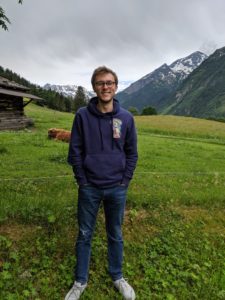
Alles geht mir sehr gut in Deutschland, und ich freue mich auf die Abenteuer, die ich noch haben werde! Bis meine nächste Post!
Moving on to Renaissance Latin
This past week we visited the Amphitheater of Maecenas, two Benedictine Monostaries, St. Peter’s Basilica, and the Villa Borghese. We also took a day-trip to Florence where we went on a walking tour of the city, including the Palazzo Vecchio and the Duomo. That afternoon we broke up into different groups to visit different sites. I chose to go to the Uffizi. Afterwards, we all met back up at another Benedictine monastery for Vespers in Latin. Throughout our visits, we stopped to read Latin inscriptions where we found them. At the museums, our teachers also continued to give us tours in spoken Latin.
To get ready for our visit to Florence, we started studying and reading more Medieval and Renaissance Latin this week, including accounts of St. Benedict and St. Francis, the Donation of Constantine, and writings by Poggio Bracciolini and Lorenzo Valla. We discussed some of the differences between them and classical Latin and how some Renaissance men attempted to return to classical Latin. We particularly focused on the Donation of Constantine for this and how Lorenzo Valla disproved its claims by examining it philologically and showing that the Latin used did not match the period in which it claimed to have been written.
This coming week, we’re going to continue working on Renaissance Latin, before we return to Classical Latin for the last week.
Onuma Trip & More
Today is June 30th. It’s been a few weeks since I’ve last written, and a lot has happened. This past weekend was the group trip to Onuma! As an entire program, we journeyed to a much more rural area of Japan’s northernmost island (only about a 30 minute drive) where we were able to explore the beautiful little town, and stay in a more traditional style hotel. While the trip didn’t have an emphasis on progressing our skill of the Japanese language, it did help us get to know the other students in the program better.
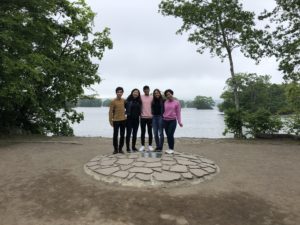
Because the students studying here are of various skill levels, the classes are divided up making it hard to interact with students of different levels, especially when we’re only allowed to speak in Japanese at the school. Another way, however, that I’ve been able to befriend students in the program has been through the 文化講座, or the after school cultural courses. These have been various after school activities that focus on the culture, rather than the language, and are open to all the students as long as there are still spots available. As of now, I’ve done Kyudo, which is the Japanese form of archery, and Kendo, which is Japanese sword fighting. Both have been extremely fun and memorable, see photos/videos below, and I hope to participate in more in the future.
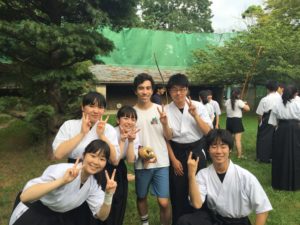
Since last time, I’ve also attended my first 会話テーブル, or language table, that the program offers. HIF recruits students studying at nearby colleges to come in and talk and play games with any of the HIF students that who are willing. This was a really good experience as it was my first time talking to a Japanese native who was my age, in Japanese. Like the cultural courses, I hope to attend more of these in the future as I feel that they are not only fun, but have improved my comfort in speaking the language much more.
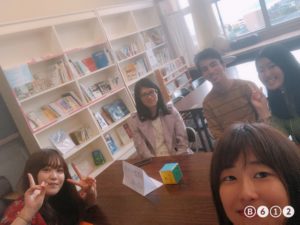
Lastly, I’ve finally been able to start working on my IS. The HIF program requires all students to complete a self designed Individual Study (IS) project before being able to graduate. The topic is completely open-ended as each student creates the project and grading rubric by themselves. The only guideline is that the project should have something to do with the local Hakodate community, where you are interacting with the locals in one way or another. The proposal for our projects were due last week, and I decided that I wanted to play soccer with the locals. I haven’t exactly figured out how I’m going to do this, but I recently talked to some of the school’s staff who told me they would reach out to a few local high schools. I’m hoping that I can attend one or two of the high school’s practices and play myself. I play varsity soccer back in high school, and I participate on Keenan’s inter-hall team back at ND, so I think it would be really neat to be able to compare and contrast Japanese and American soccer play styles.
Blog Post 3
To begin my fifth week in Tours, I decided to wake up early on Sunday to explore parts of the city that I had not yet seen. For a late breakfast, I met my friends at a small café that one of their host moms had recommended. She told us to try the poached eggs au chinon. I had certainly seen poached eggs many times, but I had never tried them, so I did not know what to expect.
Two eggs were served on a small piece of baguette with spinach and tomatoes on the side. It was one of the most delicious meals I have ever had. My friends and I thought that they looked very similar to over-easy eggs but we all agreed that they tasted at least slightly different, and so one of my friends asked the waitress (with some help from Google Images) the difference between the two dishes. She explained that poached eggs are boiled, while over-easy eggs are simply fried in a pan. Our waitress also told us that these eggs were among the most popular local dish, though omelets were also popular.
After breakfast, my friends and I went to the Botanical Garden in Tours. The city has many beautiful gardens, especially considering its relatively small size. My host mom told me that the gardens in Paris are essential to the Parisian culture, and a point of pride for the residents of the city, and that Tours has a similar relationship with its public gardens and parks. There is another park that my friends and I have visited multiple times called l’Île Simon, which is a small piece of land in the middle of the Loire. We go there after classes some days to play cards.
À bientot!
Weeks 1 and 2 In Rome
So far, the program has been great. The Latin immersion is helping my reading speed more than any other Latin class I’ve taken. While we do traditional classroom instruction 4 days of the week, often site visits are almost entirely in Latin. Our tours through Sperlonga, the Capitoline, the Catacombs of St. Priscilla, the Ara Pacis, and Pompeii were only in Latin. I can follow most conversations and directions now, but responding is still pretty slow for me. I’ve found that my grammar is pretty good already from my previous Latin classes, but my vocabulary is not up to par since most of the translation I’ve done has not been conversational Latin. My reading speed is already much better, however, and I’ve been practicing vocabulary on my own in addition to our scheduled classes.
I was used to being able to take my time on translation before, since for most Latin classes, you prepare you translation beforehand and are able to use a dictionary when needed. With Living Latin in Rome, we are often expected not only to translate on the spot and sight-read, but also to follow conversations and respond quickly. I can already tell that I’m finding it faster and easier after just two weeks and speaking has also helped my reading speed.
Our site-visits each week also help to put everything in context for me. When reading texts, I actually have a reference for where things were relative to each other and how far apart they were. Knowing the geography of Rome has also helped my reading speed since I can better understand what the authors are referring to.
So far, we’ve visited the Campus Martius, the Capitoline, Sperlonga, the Forum, the Palatine, Ostia, the Ara Pacis, the Catacombs of St. Priscilla, the Naples Archaeological Museum, Vesuvius, Pompeii, and Cumae.
Das Herz Bayern
“Das Herz Bayern,” “the heart of Bavaria” is a lovely and entirely fitting moniker of Altötting, Germany, where I have decided I will certainly retire when I have made my millions. A beloved town of Pope Benedict XVI, whose childhood home in the nearby town Marktl am Inn I was also fortunate enough to visit, Altötting has found a special place in my heart with its timelessness, its smallness, and its unique devotion to the Blessed Virgin Mary. Bavaria is the most Catholic state in Germany, and Munich has a number of interesting roots in the Catholic Faith; however, it wasn’t until I visited Altötting that I could see a people really grounded in their love for Christ and in such profound way.
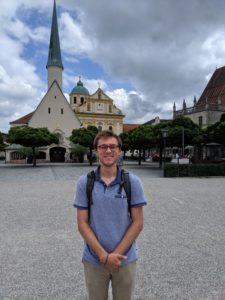
Altötting has become a regular pilgrim site for a number of Catholics from all over the world due to the steadfastness of its patron, Our Lady of Altötting, the mother of Jesus. Many have come from near and far seeking healing through the intercession of Our Lady, and many, after visiting the real center of the town, Gnadenkapelle, which houses a beautiful statue of “Die Schwarze Madonna,” “the Black Madonna,” have received their sought-after healing. In fact, both inside and outside, paintings thanking Mary for her intercession line nearly every wall, leaving hardly any view of the wood on which they hang. Most say something to the effect of, “Maria hat uns geholfen. Tausend Dank,” “Mary helped us. A thousand thanks!” Not only do these paintings exist as proof of her aid, but on a cross outside the chapel hang a number of crutches, braces, and canes which were no longer needed after their users’ trip to the Gnadenkapelle. The devotion was penetrating.
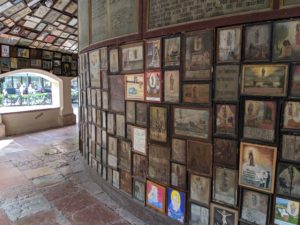
Outside of Altötting, however, the Christian influence remains in the number of public Christian holidays, some of which are observed only in Bavaria, others all throughout Germany. Since I have been in Germany, I have gotten off from school on three separate occasions due to public Christian holidays. In fact, today, June 20, is “Fronleichnamstag,” or Corpus Christi, a public holiday for all of Bavaria. However, what intrigues me is that, upon talking with a number of people about the holiday, no one knows what it’s all about. The priest celebrating Mass today explained it in the context of today’s Gospel reading from the Gospel of Luke in which Jesus feeds a couple thousand people with no more than five loaves of bread and two fish. Corpus Christi is an especially Catholic celebration of the Body and Blood of Christ, really present in the Eucharist, the spiritual food through which one may be sustained by Christ. My teacher in the Carl Duisberg Centrum, a native of Munich, nor any of my classmates whose homes span four different continents knew why we had the day off (Admittedly, I was also unaware of the real significance of the holiday). The mother of my host family also did not understand the holiday, nor was she surprised that most people were unsure of its significance either despite the fact that the entire state gets off of work for the entire day for it. Although Bavaria is largely culturally Catholic, indeed with its large number of practicing Catholics, Munich, most of Bavaria, and all of Germany are growing largely secular, with many people leaving Catholicism and Christian faiths of all kinds. I have found no real explanation for this trend, however, but I look to places like Altötting with confidence that the heart of Bavaria beats strong.
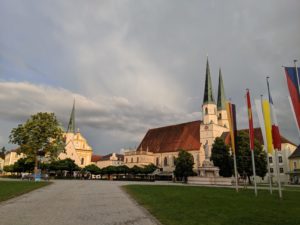
Maria hat uns geholfen. Tausend Dank. Bitte, hilfe uns weiter!
Initial Thoughts
Hello! Today is June 19th — exactly one week after I’ve arrived in Japan. Although I’m still adjusting to the time difference, my experience so far has been amazing. The first few days I stayed in a hotel with the rest of the students that are attending the same program. We went through a long and tedious, yet necessary orientation regarding Japanese culture, how to interact with out host families, and what to expect to get out of the program. It seemed a bit overwhelming at the time, but now that classes have started I’ve settled down a little bit. After staying at the hotel (and eating some pretty amazing food) we were all assigned to our host families.
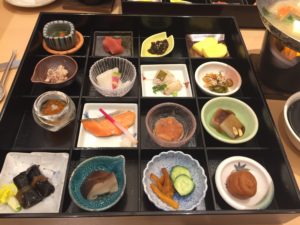
My host family is a mother, father, and two big dogs — Tony and Mary. I’ve been living with them for a few days, but I’ve already grown more comfortable speaking Japanese with them. I’ve also determined that they can hardly speak any English, so while it will be a struggle at times, I know my Japanese will improve a lot.

Furthermore, class has also been pretty fun. Our teacher, 野間先生 (Ms. Noma), seems like a super cheer upbeat and cheerful teacher. I was initially nervous about having class for three hours a day, five days a week, but I’ve learned that the time is divided up smartly amongst three periods, with adequate breaks in-between. Furthermore class has also been quite entertaining, so the time passes by quickly. But although it’s been fun so far, I’ve realized how much more Japanese there is that I need to learn. It will be interesting to see how far I’ve come when I check in next.
Update from Tours!
My time in Tours is going so fast!! It’s very difficult to believe that it is more than halfway over.
I have spent the last couple of weeks exploring Tours and taking advantage of the cultural excursions that the Institute of Touraine offers. We first went to the Chateau of Chenonceau, which was a beautiful castle in a small, charming town called Chenonceaux. Most recently, I visited Mont St. Michel in Normandy and St. Malo in Brittany. Mont St. Michel is an island that hosts an incredible building that has served as a monastery since the eighth century. St. Malo, a city on the English Channel, is about an hour drive from Mont St Michel, and is the prettiest place I have ever seen.
On my excursion to the Chateau of Chenonceau, I spent much of my day talking to a woman from El Salvador named Carolina. Carolina lived in Los Angeles for twenty years but decided to leave about eighteen months ago. About two years ago, her mother had come from El Salvador to visit her, and while in the grocery store they were talking to each other in Spanish. Carolina told me that someone yelled down the aisle at her “This is America! Speak English!”
When she finished telling me this story, I felt angry, but mostly, I felt embarrassed and ashamed. I thought of how many times I had called home in a café during my time here and spoken English, or how many times I had made grammatical mistakes while communicating with cashiers and waiters. I think that I have always maintained, to some degree, the naïve image of the US as the home of immigrants. Evidently, for plenty of immigrants, many Americans have proven that our country does not deserve this label – at least not now. Carolina told me that she believes that the United States underwent a cultural change in 2016, and that she felt that as an immigrant, she could never feel like a part of the country, regardless of how many years she lived there, or how well she spoke English.
Beyond the cultural excursions, I have been so fortunate in my classmates and instructors. The people class come from many places across the globe and range in age from nineteen to sixty-five. I have been able to learn so much, not strictly from the curriculum, but also as a result of meeting these incredible individuals and talking to them about the differences between our cultures.
In one of my morning classes, our daily assignment is to read the French newspaper and present to the class a summary of an article that we found interesting. This has resulted in many interesting debates, often centered around American politics. Following a particularly exciting discussion, I asked one of my friends from the class, who is from India about her impression of the political situation in the United States. She told me that growing up, she had always been infatuated by the idea of American popular culture, because of how easily accessible it was to youth in India. She had the impression, at a young age, from films and television shows, that women were treated with more respect in the US than in her country, and this idea was very inspiring to her. My friend says that she believes that women’s rights are progressing in India, but that certain restrictions still exist. For example, arranged marriages are still very popular across the country. In respect to the United States today, it was shockingly difficult to hear my friend’s current position. I listen to, and typically agree with, my classmates’ negative opinions about our country’s politics daily in class, but it was hard to hear the loss of hope in my friend’s tone. She still wants to work in the United States, but she told me that many of her friends had tried and failed multiple times to receive visas in recent years, despite having multiple degrees. She also told me that she fears that women’s rights seem to be regressing, and that she does not know if she wants to move to a country where that is the case, when she could be a part of the exciting progress being made in India.
I have also found myself becoming more engaged with my host family, who could not be more welcoming. Last weekend, my host mom invited me to her granddaughter’s Confirmation lunch. I was able to meet her entire family.
One of the cousins, Matthieu, was two years older than me and spoke English very well. He was interested in international economics, so, as he explained, English was essential. To learn English, Matthieu had gone to Sweden, which was very interesting to me. It was also fascinating to hear his opinion of American politics. His opinion of the current state of American affairs was far more optimistic that those of my two classmates. Matthieu told me that he felt inspired by the youth of America, in relation to the France’s young population. As he saw it, politically, American youths are more optimistic and hold a more comprehensive worldview. I was inspired by this hopeful, albeit simplistic, interpretation of the American political climate, and it reminded of many conversations from my French classes at Notre Dame, about the differences between political trends between our two nations.
I am so grateful for every aspect of this trip thus far, from my new friends and the beautiful places I have seen, to the improvement in my French speaking and writing, but I think that I am perhaps most thankful for my deeper comprehension of international relations, and the role that the United States plays in global affairs.
A Wonder of the World: Machu Picchu
This past weekend, I experienced the highlight of my time in Peru thus far–a trip to Machu Picchu. This wonder of the world was built in the 15th century to house the ruler of the Incan empire. Nestled above the Sacred Valley of Peru, Machu Picchu is 50 miles from Cusco and wasn’t discovered by the Spanish when they invaded, which allowed the structures to be preserved. Only locals were aware of the ruins until 1911, when a Yale historian discovered the site through the guidance of a young boy from the region.
My friend David, also a ND student studying Spanish in Cusco, and I traveled by bus and then train to the small town of Aguas Calientes. While more touristy than Cusco, we both agreed that the community was beautiful and a great place to stay for the night. We ate at one of the many restaurants attempting to lure us in, tempted by the offer of free drinks and guacamole. We also visited the hot springs in Aguas Calientes before turning into our hostel in preparation for an early-morning bus ride up to Machu Picchu.
 The train ride to Aguas Calientes was beautiful!
The train ride to Aguas Calientes was beautiful!
 A river runs through the center of the town, with many restaurants and hostels on either side.
A river runs through the center of the town, with many restaurants and hostels on either side.
On Sunday, our group departed for the site at 5:30am, and we made it up the mountain and to a viewpoint of Machu Picchu as the sun was appearing. I had seen dozens of photos previously, but nothing could compare to actually experiencing Machu Picchu in person. The abandoned city was much larger than I expected, and it was incredible to walk through the ruins with our guide and learn about the significance of specific structures.


After countless pictures and walking through the site, my group bid farewell to Machu Picchu and hiked for about an hour back down to Aguas Calientes for lunch and to catch our train back to Cusco. This is definitely a trip I will never forget, and I have dreams of returning in the future and sharing the experience with others.